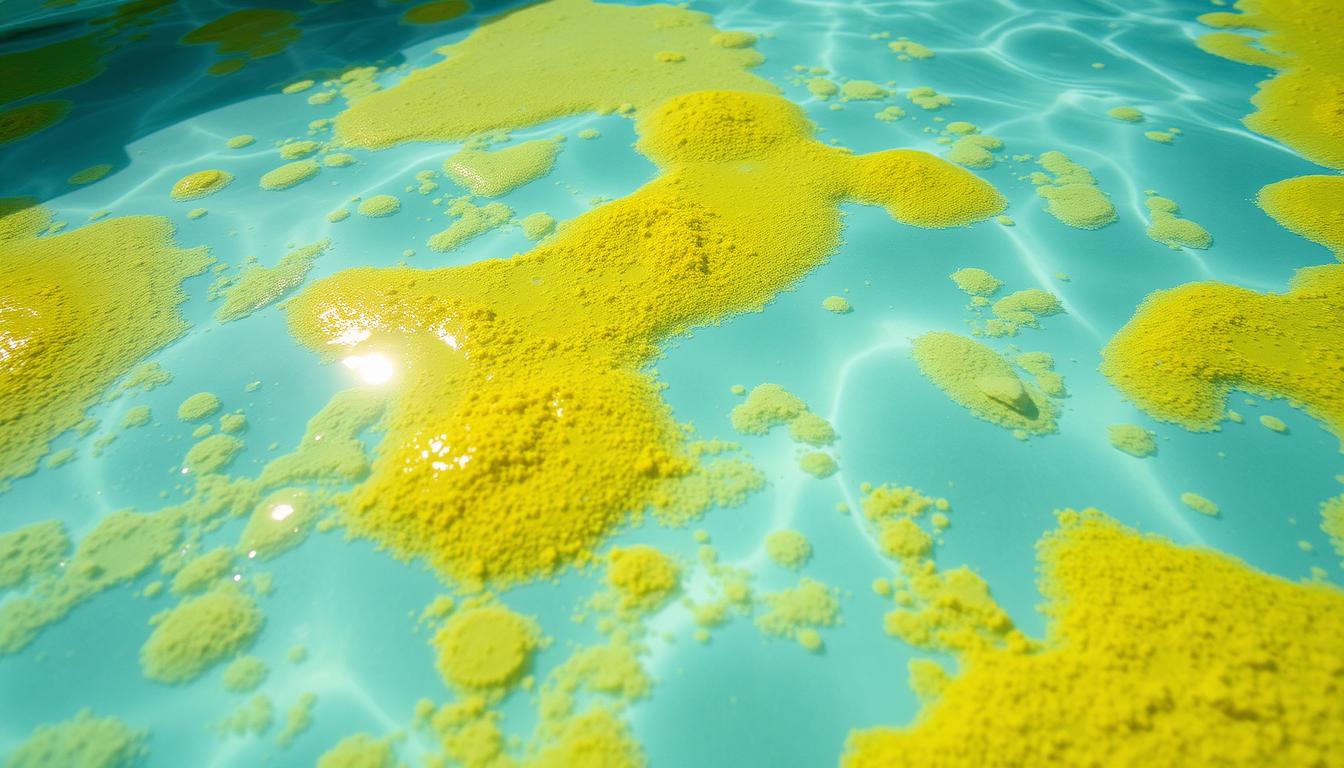
Mustard algae can ruin your pool’s cleanliness and safety. This stubborn algae resists chlorine and clings to pool surfaces. It’s a variant of green algae that’s hard to remove.
Unlike floating green algae, mustard algae sticks to walls, floors, and equipment. It can even attach to pool toys and ladders. This makes it a persistent problem for pool owners.
Mustard algae often looks like dirt or sand. This can lead to confusion and misidentification. A closer look reveals its unique characteristics.
Knowing how to spot mustard algae is crucial. This guide will help you identify and tackle the issue early. Quick action can prevent it from taking over your pool.
Key Takeaways
- Mustard algae is a chlorine-resistant variant of green algae that clings to pool surfaces
- It often resembles dirt or sand, making it easy to misidentify
- Mustard algae can mar the aesthetics of your pool and potentially pose health hazards
- Identifying mustard algae early is crucial for effective treatment and prevention
- A visual guide can help you recognize the distinct characteristics of mustard algae
Understanding Yellow Mustard Algae in Pools
Yellow mustard algae can quickly turn a sparkling pool into an unsightly mess. It’s a pesky problem that pool owners often face. Let’s explore what yellow algae is and why it grows.
What Is Yellow Algae?
Yellow algae, or mustard algae, is tougher to remove than green algae. It forms powdery clumps on pool walls, especially in shaded areas. While easy to brush off, it resists chlorine and needs special treatment.
Yellow algae is more than just an eyesore. It can pose health risks if left untreated. Many pool owners underestimate its potential dangers.
Studies indicate that around 70% of pool owners mistakenly believe that mustard algae is harmless and only affects the pool’s appearance, disregarding the potential health risks associated with prolonged exposure.
Causes of Mustard Algae Growth
Chemical imbalances in pools can lead to mustard algae growth. Poor water circulation and filtration also contribute to the problem. Debris, phosphates, and warm temperatures create ideal conditions for algae.
- Research suggests that approximately 80% of mustard algae cases in pools are due to suboptimal chemical balancing, emphasizing the importance of regular testing and proper chemical treatment to prevent infestations.
- Yellow algae tend to thrive in environments with low circulation and inadequate sanitation.
- Observational data indicates that natural water bodies with high levels of nitrogen and phosphorus are 80% more susceptible to mustard algae colonization, emphasizing the key role of nutrient management in controlling algae proliferation.
| Prevention Measure | Importance |
|---|---|
| Maintaining chlorine levels between 1-3 ppm | Prevents yellow algae growth |
| Regularly brushing and vacuuming the pool | Prevents algae spores from taking hold |
| Running the filter for longer periods during warm weather | Helps prevent algae growth in pools |
| Monitoring chlorine levels, pH balance, and alkalinity weekly | Essential for preventing algae growth |
Knowing about yellow mustard algae helps pool owners prevent infestations. Regular maintenance and proper chemical balance are crucial. Quick action when algae appears keeps pools clean and inviting all season.
Identifying Mustard Algae: Visual Characteristics
Pool owners need to spot mustard algae quickly. This yellow algae has unique traits. Recognizing it early helps maintain a clean, healthy pool.
Color and Appearance
Mustard algae leaves light yellow or tan stains on pool surfaces. It’s not slimy and doesn’t brush off easily. The stains spread evenly around pool walls.
This color and appearance make mustard algae stand out. It’s different from dirt or other pool debris.
Location and Growth Patterns
Mustard algae thrives in shady pool areas. It grows where sunlight is scarce. Poor water circulation spots, like corners, are prime locations.
This algae resists normal chlorine treatments and brushing. That’s how it differs from other pool contaminants.
| Algae Type | Color | Texture | Location | Chlorine Resistance |
|---|---|---|---|---|
| Mustard Algae | Light yellow or tan | Non-slimy, doesn’t easily brush off | Shady areas, poor circulation | High |
| Green Algae | Green | Slimy | Sunny areas | Low |
| Black Algae | Dark spots | Rough, deep roots | Deep end, shaded surfaces | High |
High cyanuric acid levels can weaken chlorine against mustard algae. Regular water testing is crucial. Balancing pool chemistry helps prevent algae growth.
What Does Mustard Algae Look Like Compared to Other Algae Types
Algae in pools come in various types. Mustard algae is less common than green or black algae in Dallas-Fort Worth. Recognizing its unique features helps treat and prevent its growth effectively.
Green Algae
Green algae is the most common type in North Texas pools. It floats freely, causing a green tint, or makes surfaces slippery. Low chlorine and poor circulation help it thrive.
Treating green algae requires balancing pool chemicals and shocking the water. Vigorous scrubbing, circulation, and vacuuming are also necessary steps.
Black Algae
Black algae is the toughest to remove due to its chlorine resistance. It appears as small, dark spots with deep roots in pool surfaces.
Black algae is rare in Dallas-Fort Worth but common in coastal areas. Treatment involves shock treatment and thorough scrubbing to break its protective layer.
Mustard algae differs from green and black types in color and growth habits. It’s yellow, resists brushing, and prefers shady pool areas.
Understanding these differences helps pool owners identify and treat algae effectively. This ensures a clean and healthy swimming environment for everyone.







